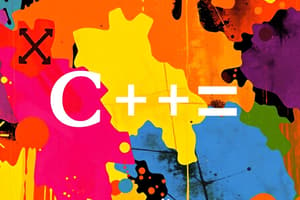Podcast
Questions and Answers
What is a class in C++ and why is it important in object-oriented programming?
What is a class in C++ and why is it important in object-oriented programming?
A class in C++ is a user-defined data type that serves as a blueprint for creating objects, holding its own data members and member functions, which are essential for encapsulating properties and behaviors in object-oriented programming.
Explain the difference between data members and member functions in a class.
Explain the difference between data members and member functions in a class.
Data members are the variables that hold data, while member functions are the functions that manipulate these variables, together defining the structure and behavior of the class objects.
How do you create an object of a class in C++?
How do you create an object of a class in C++?
To create an object of a class in C++, use the syntax ClassName ObjectName; to declare the object.
Describe the purpose of the dot operator ('.') in accessing class members.
Describe the purpose of the dot operator ('.') in accessing class members.
What does it mean when a class is described as 'empty' in C++?
What does it mean when a class is described as 'empty' in C++?
Why is 1 byte allocated for an empty class when instantiated?
Why is 1 byte allocated for an empty class when instantiated?
What are the access levels defined by access specifiers in a class?
What are the access levels defined by access specifiers in a class?
Can you create an array of objects in C++, and if so, how?
Can you create an array of objects in C++, and if so, how?
What implications does the absence of data members in an empty class have on its functionality?
What implications does the absence of data members in an empty class have on its functionality?
How does access control influence the use of member functions in derived classes?
How does access control influence the use of member functions in derived classes?
In what scenarios is it appropriate to define member functions outside the class in C++?
In what scenarios is it appropriate to define member functions outside the class in C++?
Describe a situation where creating an array of objects would be beneficial.
Describe a situation where creating an array of objects would be beneficial.
What advantages do data members in a class confer for object-oriented programming?
What advantages do data members in a class confer for object-oriented programming?
How does instantiation time impact memory allocation for an object of a class?
How does instantiation time impact memory allocation for an object of a class?
What does it signify when an instance of a class is created after the class definition in C++?
What does it signify when an instance of a class is created after the class definition in C++?
Explain why the dot operator ('.') is crucial in object-oriented programming with respect to class instances.
Explain why the dot operator ('.') is crucial in object-oriented programming with respect to class instances.
Flashcards
Class (in C++)
Class (in C++)
A blueprint for creating objects; defines data (variables) and actions (functions) that objects of that type can perform.
Data members
Data members
Variables inside a class that hold data.
Member functions
Member functions
Functions inside a class that perform actions on data members.
Object
Object
Signup and view all the flashcards
Accessing members
Accessing members
Signup and view all the flashcards
Empty Class
Empty Class
Signup and view all the flashcards
Empty Class Size
Empty Class Size
Signup and view all the flashcards
Array of Objects
Array of Objects
Signup and view all the flashcards
What is a C++ class?
What is a C++ class?
Signup and view all the flashcards
How to access members?
How to access members?
Signup and view all the flashcards
Why does an empty class take one byte?
Why does an empty class take one byte?
Signup and view all the flashcards
Study Notes
Classes in C++
-
A class is a blueprint for creating objects. It acts as a template that defines the data members (attributes) and member functions (methods) that objects of that class will have.
-
Classes are crucial in object-oriented programming (OOP) because they enable programmers to model real-world entities and relationships in a modular and reusable way.
Data Members & Member Functions
-
Data Members: Variables declared within a class that represent the state or attributes of an object. They hold the data associated with an object. Example:
name,age,balance -
Member Functions: Functions defined within a class that represent the actions or behavior of an object. They operate on the data members to manipulate the object's state. Example:
deposit(),withdraw(),display().
Creating Objects
- You create an object of a class by using the class name followed by the object name. Example:
Account myAccount; - The object
myAccountnow holds the data and functionality defined by theAccountclass.
Dot Operator ('.')
- The dot operator (
.) is used to access the data members and member functions associated with a specific object of a class. - Example:
myAccount.balance = 1000;sets the balance attribute of themyAccountobject to 1000.
Empty Classes
- An empty class in C++ is a class without any data members or member functions.
- To prevent the empty class from occupying zero bytes in memory (which could lead to ambiguity during memory allocation), the compiler allocates a single byte to an instance of an empty class.
Access Specifiers
- Access specifiers (public, private, protected) define the accessibility of data members and member functions within a class.
public: Members are accessible from anywhere.private: Members can only be accessed within the class itself.protected: Members can be accessed within the class and its derived classes.
Arrays of Objects
- You can create an array of objects in C++ using the class name followed by the array name and size in square brackets. Example:
Account accounts[100]; - This creates an array called
accountsthat can hold up to 100Accountobjects.
Implications of Empty Classes
- An empty class, despite having no data members, still serves as a template for creating objects.
- The one-byte allocation helps in distinguishing between empty classes and incomplete types.
- Empty classes are often employed as base classes to provide specific behaviors to derived classes without introducing new data members.
Access Control and Derived Classes
- Access control specifiers influence how member functions of a base class can be used in derived classes.
- If a member function in the base class is declared as
private, it cannot be accessed in derived classes. - If a member function is declared as
protected, it can only be accessed in derived classes.
Member Functions Outside the Class
- Member functions can be defined outside the class declaration using the scope resolution operator (::).
- This can improve code organization and readability, especially for large classes with many member functions.
- Example:
class MyClass {
public:
void myFunction();
};
void MyClass::myFunction() {
// Function body
}
Benefits of Arrays of Objects
- Arrays of objects allow you to manage and manipulate a collection of objects of the same class efficiently.
- They provide a convenient way to store and access multiple instances of the same type.
- Example: In a student management system, an array of
Studentobjects can store the details of all students.
Advantages of Data Members
- Data members allow you to encapsulate the internal state of an object, making it self-contained and reducing the risk of unintended modifications.
- They improve code organization and maintainability by grouping related data together.
Instantiation Time & Memory Allocation
- Memory for an object is allocated when the object is created (instantiated).
- Data members are allocated dynamically on the heap when the object is created.
Instantiation After Class Definition
- Object creation after the class definition signals that the class has been fully defined and can be used to generate instances (objects).
Dot Operator & Class Instances
- The dot operator is crucial in object-oriented programming because it allows you to interact with individual objects (instances) of a class.
- It provides a way to access the data and functionality of a specific object using the object name and the dot operator.
- This is fundamental to object-oriented programming as it enables data encapsulation and modularity.
Studying That Suits You
Use AI to generate personalized quizzes and flashcards to suit your learning preferences.




